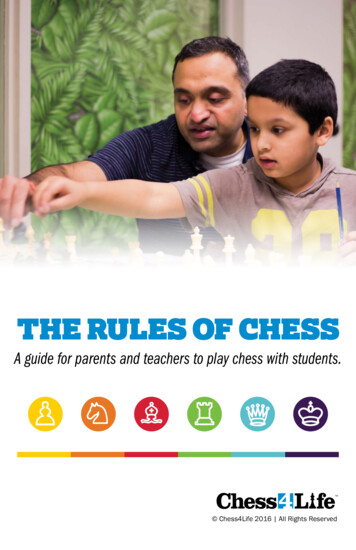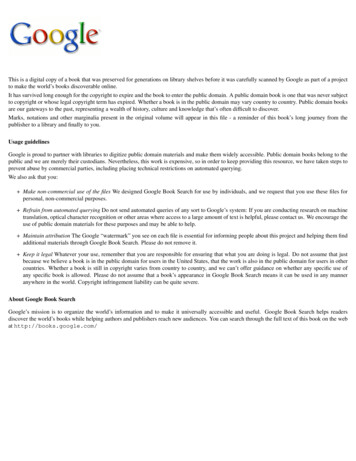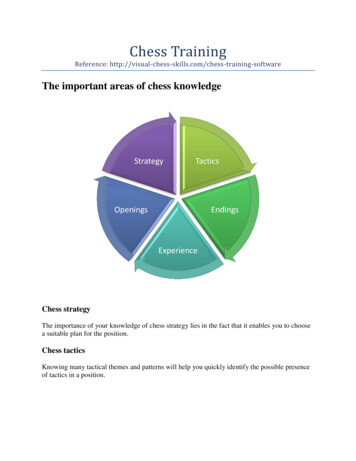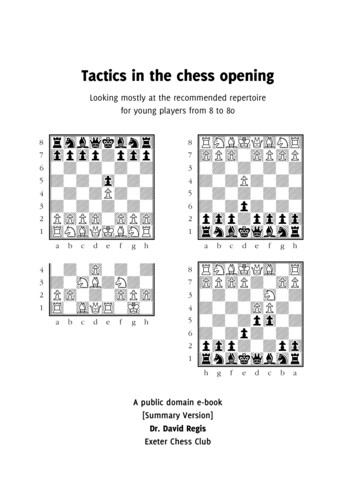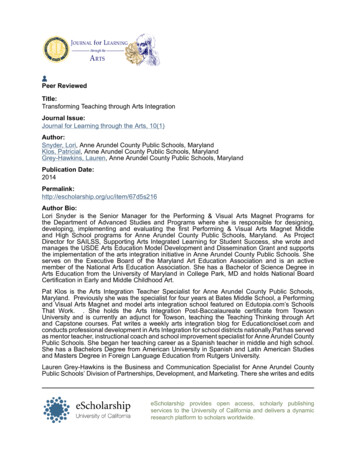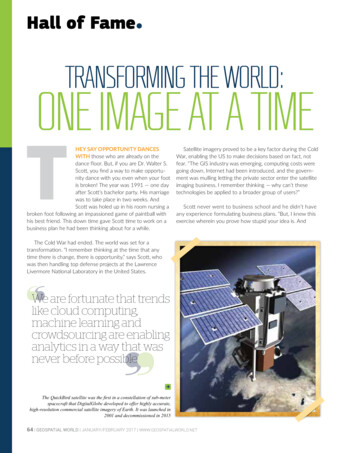![Chess Transforming Care Tues PM Diamond B.ppt [Read-Only]](/img/11/transforming-care.jpg)
Transcription
Transforming CareMaking Our NursingF iliti SafeFacilitiesS f ToT ProvideP idAcute Medical Care On SitePPresentedd bybDr. David ChessfAssociate Professoroff MedicineYale School of MedicineChief Medical Officer AristaCare Health ServicesProprietary and Confidential
Strategies for Transforming CareCreating a Medical Foundation for CareProprietary and Confidential
Agenda1. What’s Driving Change2. The New Health Care Paradigm3. Why Change Now4. Quality Care Strategy5. Outcomes1. Clinical2 Financial2.Fii lProprietary and Confidential
h ’ Drivingi ihWhat’sChange?MONEYGovernment Driven Change Health Care is bankrupting ourcountry % of GNP spent on healthcare climbedfrom 15% in 2000 to 17.9% in 2011. Medicare is running out ofmoney Medicaid is running out ofmoneyProprietary and Confidential
The New Health Care Paradigm Hospital New Reality Increasing Penalties Empty Beds Accountable Care and Bundled Payments are coming Managed Medicaid is comingProprietary and Confidential
What The New Paradigm Demands? Hospital - Empty Beds Nursing Facilities – Keep the Beds Filled(But not for too long)Proprietary and Confidential
Th JerseyJLdTheLandscape Managed Medicaid launch is now set for July 20145 to 8 companies set to aggressively enroll our Medicaid patients Will want to manage residents and control high cost events Prevent Hospitalizations ObtainObt i AdAdvancedd CareCDiDirectivesti(POLST) Health PlansBlues entering risk contracting United will have 5 Products in market and is sharing risk (and reward) withnursing facilities Amerigroup is thinking about more value based relationships All payers in process of developing value based contracting structures Hospitals are Partnering with their physicians and other providers (SNFsand Home Care agencies),agencies) creating ACO’sACO s and transition of care modelsmodels. From large systems (Robert Wood Johnson), to smaller systems (Raritan Bay)Proprietary and Confidential
What the Market is looking for? Quality Nursing Facilities Reliable care partners Control hospital admissions Be able to provide advanced care on site Able to measure performance Able to manage their physiciansProprietary and Confidential
The Train Has Leftf the Station Proprietary and Confidential
Whi h WayW tto Go?G ?WhichIt was the best of times.It was the worst of times.Proprietary and Confidential
The Quality StrategyQuality on site medical /nursing careProprietary and Confidential
Post Acute CareQuality is Front Page Reducing Unnecessary Hospitalizations ofNursing Home ResidentsJoseph G. Ouslander, M.D., and Robert A. Berenson, M.D.N Engl J Med 2011; 365:1165-1167 September 29, 2011 23% of post acute patients in SNFs are return tohospital in 30 days. At least 40% of these are believed to be avoidable. Cost 4,000,000,000,,,Billion pper yyearProprietary and Confidential
The Foundation Requires Cultural Transformation Create a Caring Environment Clinical Transformation Provide Low Tech Hospital Level CareProprietary and Confidential
pOur Prescri ption“TheThe Better Care ModelModel”A medical/nursing modelsupportingppg Safef Care on SiteProprietary and Confidential
The Key Ingredients DevotedDt d OrganizedOi d MedicalM di l StaffSt ff Adherence to Best Care Practices Minimize Phone Based Medicine - on site care for change of condition Onsite Care by an NP 5 days per week LiveMD - Our After Hour Care Physician Care Program Admission Risk Assessments Heroes Program – cultural transformation Clinical Enhancement Initiative Post Discharge - integration and follow up Software to measure what we do and how wellwe do it - outcomesProprietary and Confidential
It Starts with the Medical Staff Create Integrated Medical Staff Adopt Medical Staff bylaws Establish Medical Executive Committee in each facility The Committee is Responsible: C t andCreatesd enforcesfa professionalf il coded off conductd t Defines attending responsibilities Creates standards of care Creates and approves guidelines and protocols Corporate Medical Director provides support and guidance to the facilitiesMedical DirectorsProprietary and Confidential
Sample Programs Proprietary and Confidential
Clinical Protocols (Samples): Coumadin Clinic Heart Strong a engagement system of care for people with HeartConditions POLST – integrating advanced care planning and palliative care Proton Pump Inhibitors Guidelines Blood Transfusion Guidelines DVT Prophylaxis Guidelines Respiratory Care Systems DM Care Protocols CardiacC di MMedicationdi ti MMonitoringit i PProtocolstlProprietary and Confidential
T h e N P - Provides AcuteA t OnsiteO it CareC Chronic Condition Management (not monthly routine visits) Resident Risk Assessments and Re Admission AvoidanceInterventions Quality Indicators Management (“Survey Ready”) RN/ LPN/Aide Directed ongoing Educational Program Transition of Care - Provide discharge summary and calls to patientscommunity physicians, assuring a safe transition and follow upphysician care.Proprietary and Confidential
HPHeroesProgram Making All Of Our Associates Part Of Our Care Team: Applying the Interact – “Stop and Watch” early warningtool Education, training and support for all of our associates,bi i tht our residentsid t lid tto hl kbringingthem iintolives andhelpkeep ourresidents well. All of our Associates Nurse AssistantsEnvironmental ServicesMaintenanceDietaryyRecreationSocial ServicesRehabilitationProprietary and Confidential
Clinical Enhancement Initiative“The Ingredients” Nursing Engagement and Training: Symptom Specific Tools Driving Improved Assessments, Documentation andCommunication Implement DON Morning Rounds Imbed a CQI Process and Measures into all we do Symptom Specific Assessment Tools Include: Respiratory Symptoms - SOBAbdominal SymptomsFever / SepsisChest PainChange in Mental Status / CVAHypo and HyperglycemiaSuspected UTIFallsProprietary and Confidential
Setting the Culture Rewarding Caring Medals Gift certificates Internal Newsletter Letting our physicians know External Press ReleasesProprietary and Confidential
Aft HAfterHours (First Call for Acute Care Issues)Powered by eSNF Only for serious medical concerns (not sleep meds, or patient fallsunlesslinjuryi jandd contemplatingtl ti sendingdi tot hhospital).it l)Each patient seen by MD via telemedicine: Exams Heart Lungs and Abdomen Exams Skin and WoundsCall Attending and Patient familyPrescribe on siteSend in note to support visitInstall equipment and Train staffTeach staff when to callNo Medicare or Medicaid Billing done100% physician acceptanceProprietary and Confidential
y eSNFPowered byProprietary and Confidential
Outcome Tracking Powered by eSNFg to ED or hospitalp Will track all ppatient events leadingadmission: ShiftNursePhysicianDiagnosisReason for TransferLOSInsurance Able to report to hospitalon readmission and quality indicatorsProprietary and Confidential
Ci bl TrackingTkiPl fCustomizablePlatformPopulation TrackingPatientP ti t Disposition:DiitiEventEt Variables:V i bl Admissions/Readmissions Reason for discharge Deaths Orderinggpphysiciany ED visits Responsible nurse Discharge to home with and Diagnosiswithout home care Discharged to alternativefacility Length of stay Time/shift Hospital Hospice Insurance Transfer to LTC Potentially Avoidable Type of admissionProprietary and Confidential
Pd byb eSNFSNFLive MD PoweredImpact Of Telemedicine ProgramSkilled Patient Hospitalization (80 SNF bed facility)Facility has a full time MD and NPProprietary andConfidential
Live MD Powered by eSNFImpact Of Telemedicine ProgramSkilled Patient Hospitalization (80 SNF bed facility)Facility has a full time MD and NPDecreased Hospitalization Rates from 20 to 12 % per MonthProprietary andConfidential
Admissions by AttendingAble to track hospital admissions by physicianas a percentage of their total patient censusProprietary and Confidential
Financial Value Equation TheReimbursementTh MedicareM diR i btper diem for the averagepatient is 500/day./ ysubacute p When a patient returns to thehospital, on average theNursing Home loses about 8days of revenue ( 4,000) ThisThi oftenft means thatth tpreventing one/makesreadmission/montheSNF pay for itselfProprietary and Confidential
Financial Impact Case Study2012 – Before eSNF2013 – After eSNFAvg.Avg SubacuteCensusTotal SubacuteBed DaysAvg.Avg SubacuteCensusTotal SubacuteBed 16341,061Total3,3793,717YoY Change 338* 338 338 add’l bed days X 500/day reimbursement 338 add’l bed daysy X 175/day/ y therapypy costs eSNF cost for March – May Customer 3-month ROI Annualized ROI 169,000 add’l revenue 59,150 new costs 9,300 in new costs 100,550 eSNF ROI 402,000*This does not include this facility’s YoY increase in long-term resident census, which in thisperiod was 472 bed daysProprietary and Confidential
Quality Care TransformationEveryone WinsProprietary and Confidential
Transforming CareCreating Best CareModelsProprietary and Confidential
H P Heroes Program Making All Of Our Associates Part Of Our Care Team: Applying the Interact – “Stop and Watch” early warning tool Education, training and support for all of our associates, b i i th i t id t li d t h l k bringing them into our residents lives an


